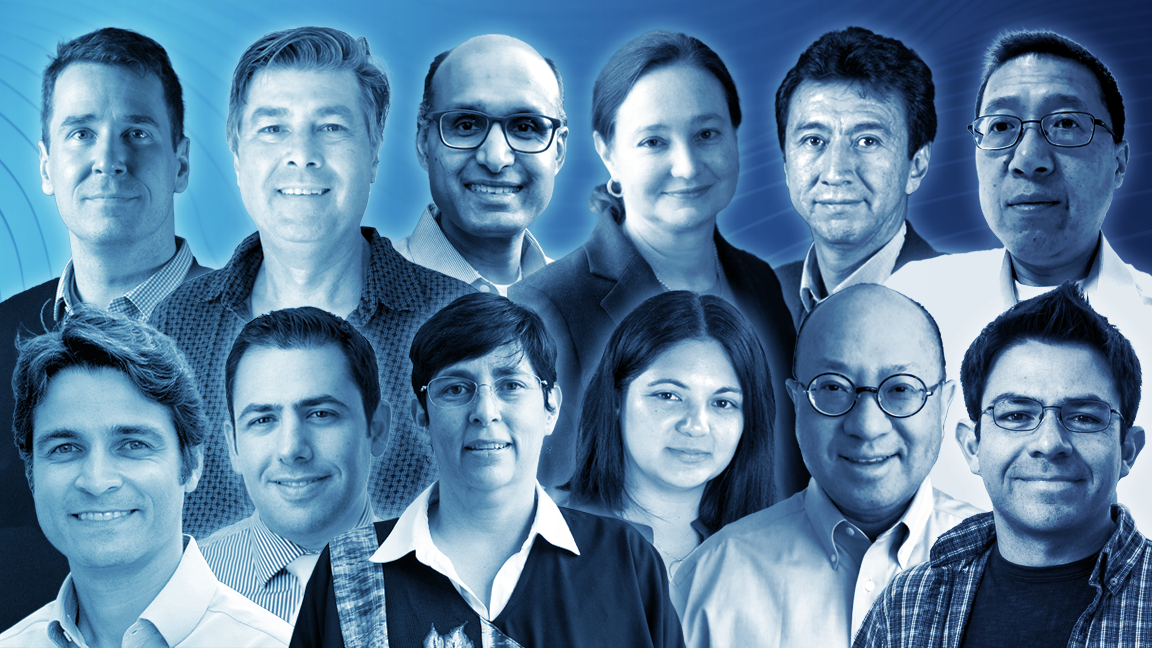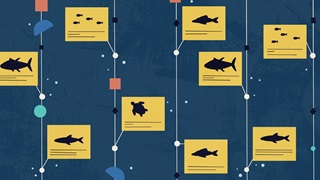Pew-Supported Scientists Partner on New Biomedical Research Projects
Innovation Fund investigators will tackle pressing questions in human biology and disease

Collaboration is often at the forefront of scientific discovery and biomedical research has long benefited from this approach. By bridging unique backgrounds and expertise, scientists have made remarkable progress in better understanding the complexities of human health and medicine. These joint efforts have led to major achievements: today, a drug can cure hepatitis C in most patients, cancer treatments can be tailored to fight individuals’ specific tumors, and COVID-19 vaccines are being rapidly reformulated to protect us from an ever-evolving virus.
For 37 years, The Pew Charitable Trusts has supported more than 1,000 early-career scientists whose work has spanned a wide range of biomedical research areas. In 2017, Pew launched the Innovation Fund to champion scientific collaboration among alumni of its biomedical programs in the United States and Latin America.
This year’s six pairs of researchers—with expertise ranging from molecular biology and neuroscience to genetics and biochemistry—will explore key questions driving innovation in human health.
A new model for tumor biology
P. Todd Stukenberg, Ph.D., and Hui Zong, Ph.D., both from the University of Virginia School of Medicine, will work to engineer a better way to study human cancer development using mice. Cancers are often driven by mutations in specific genes, but also by larger-scale genomic changes known as aneuploidy—when cells possess an abnormal number of chromosomes. However, current methods of studying tumor development in mice do not capture the aneuploidy that scientists know occurs in human tumors, an important component to fully understand how cancers develop and spread.
In his work, Stukenberg found that aneuploidy in human breast tumors may be driven by the overexpression of proteins that play a critical role in regulating chromosome stability during cell division. Using this knowledge, along with his work in chromosomal biology and Zong’s development of cutting-edge cancer models, the pair plan to engineer a new tumor model in mice that incorporates mutations along with aneuploidy. That should more accurately represent human cancer evolution and the interplay with immune responses. Findings from this model could bring a deeper understanding of tumor biology and lead to better predictive models for testing how well drugs work against the disease.
Linking repeat RNA sequences and neurodegeneration
Sarah A. Woodson, Ph.D., and Christian M. Kaiser, Ph.D., both from Johns Hopkins University, will join forces to study how repeat sequences of RNA and the subsequent RNA-protein structures they form cause neurotoxicity and neurodegeneration, both of which can disrupt or damage the nervous system. The expansion of specific RNA sequences is associated with a number of fatal neurodegenerative disorders, including Huntington’s disease, an inherited condition that affects movement and cognitive function. Researchers recently found that repeat RNA sequences can form toxic structures when assembled with other proteins. However, how these molecules come together and, in turn, damage neurons, remains unclear.
The two will combine expertise gained from Woodson’s research in RNA-folding and Kaiser’s work in single-molecule spectroscopy to develop a new platform for studying and visualizing how toxic RNA structures form in real time. This collaboration could reveal novel insights on how these structures are initiated and how they contribute to toxicity in Huntington’s disease—possibly illuminating new ways to think about treatment for a currently incurable illness.
What plant-microbe interactions reveal about iron intake
Iron deficiency affects 30% of the global population and is considered the most prevalent nutritional deficiency as well as a cause of anemia. David G. Mendoza-Cózatl, Ph.D., and Clarissa J. Nobile, Ph.D., from the University of Missouri and the University of California, Merced, respectively, are looking to plant-microbe interactions to better understand iron uptake and utilization. Recent research indicates that microbes living in plants may benefit from iron extracted through roots, and plant molecules seem to promote the colonization of beneficial microbes. But it’s unclear whether microbes play an active role in response to iron deficiency.
Combining Mendoza-Cózatl’s research in plant biology and Nobile’s study of microbial communities, the pair will dissect how iron levels are maintained by the presence of specific microbial communities and also determine how changes in iron level influence the makeup of the microbes in leaves and roots. Understanding this relationship could lead to new solutions for addressing nutritional iron deficiency through the development of iron-fortified crops.
What regenerative capabilities in animals reveal about human aging
Susana Castro-Obregón, Ph.D., and Ivan Velasco, Ph.D., both from Universidad Nacional Autónoma de México, will explore the mechanisms that protect naked mole rats and Mexican axolotls, a type of salamander, against certain elements of aging. Specifically, the pair will examine how autophagy—the cellular process of clearing away debris and damaged cells—contributes to the longevity and regenerative properties in these animals.
As humans age, autophagy often becomes dysregulated, which can lead to the harmful build-up of damaged cells and neurodegeneration. Naked mole rats have an extended life span of more than 30 years compared with mice, which typically live up to four years in captivity. Mexican axolotls are known to possess remarkable regenerative capabilities, such as the ability to regrow both the spinal cord and part of the brain if damaged. Combining expertise from Velasco’s work in neuronal biology and Castro-Obregón’s research in autophagy, the pair will explore autophagy-related genetic changes that take place in these animals to learn how they help protect axolotls and naked mole rats from aging. The scientists’ work has the potential to inform new approaches for halting the age-related neurodegeneration seen in illnesses such as Alzheimer’s and Parkinson’s diseases.
Decoding a colorectal cancer mutation
Rajat Rohatgi, M.D., Ph.D., from Stanford University, and Ethan Lee, M.D., Ph.D., from Vanderbilt University, will team up to investigate the regulation of the gene known as APC in colorectal cancer. Over 80% of colorectal cancers harbor a mutation in the APC gene, which normally helps to prevent cells from growing and dividing uncontrollably. Mutations in APC lead to the constant activation of a signaling pathway called WNT, which in turn can lead to unrestrained cell growth. Cancer therapies have been designed to target and inhibit WNT signaling, however these treatments are unable to differentiate between tumor cells with an APC mutation and healthy cells, leading to unintended toxicity and side effects.
Combining expertise from Rohatgi’s work in genomic screening and Lee’s research in WNT signaling, the pair will employ genetic-based approaches to study mutant APC and its interacting proteins to better understand how to target the mutant gene. Results from this work could inform the development of less toxic therapies that better target cancer cells while leaving healthy cells intact.
Harnessing the brain to treat schizophrenia
Mikhail G. Shapiro, Ph.D., from the California Institute of Technology, and Michael M. Halassa, M.D., Ph.D., from the Massachusetts Institute of Technology, will explore the connection between two areas of the brain in modulating decision-making in patients with schizophrenia. Schizophrenia is a mental disorder that affects a person’s interpretation of reality, through symptoms such as hallucinations, disordered thinking, problems with cognition and memory, and a variety of other symptoms. Recent neuroimaging in humans has shown that the mediodorsal thalamus is a critical brain area for tracking uncertainty in decision-making. Furthermore, the connection between this region and the brain’s prefrontal cortex is often disrupted in patients with schizophrenia.
Drawing upon expertise from Shapiro’s work in biomolecular imaging and Halassa’s research in neurobiology, the pair will investigate whether neurostimulation of the mediodorsal thalamus can enhance activity in the prefrontal cortex. Using tree shrews as a model organism, they’ll examine these two brain regions and observe behavioral effects from the manipulation. This work could enhance current knowledge of brain circuits in patients with schizophrenia and inform the development of new approaches to managing symptoms related to delusional thinking.
Kara Coleman is the project director of and Jennifer Villa is an officer with The Pew Charitable Trusts’ biomedical programs.











